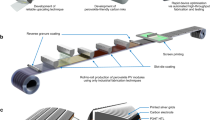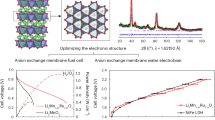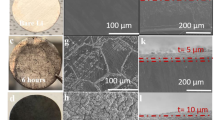Abstract
Operating stability has become a priority issue for all-perovskite tandem solar cells. Inorganic CsPbI3−xBrx perovskites, which have good photostability against halide segregation, are promising alternatives for all-perovskite tandem solar cells. However, the interface between organic transport layers and inorganic perovskite suffers from a large energetic mismatch and inhibits charge extraction compared with hybrid analogues, resulting in low open-circuit voltages and fill factors. Here we show that inserting at this interface a passivating dipole layer having high molecular polarity—a molecule that interacts strongly with both inorganic perovskite and C60—reduces the energetic mismatch and accelerates the charge extraction. This strategy resulted in a power conversion efficiency (PCE) of 18.5% in wide-bandgap (WBG) devices. We report all-perovskite tandems using an inorganic WBG subcell, achieving a PCE of 25.6% (steady state 25.2%). Encapsulated tandems retain 96% of their initial performance after 1,000 h of simulated 1-sun operation at the maximum power point.
This is a preview of subscription content, access via your institution
Access options
Access Nature and 54 other Nature Portfolio journals
Get Nature+, our best-value online-access subscription
$29.99 / 30 days
cancel any time
Subscribe to this journal
Receive 12 digital issues and online access to articles
$119.00 per year
only $9.92 per issue
Buy this article
- Purchase on Springer Link
- Instant access to full article PDF
Prices may be subject to local taxes which are calculated during checkout





Similar content being viewed by others
Data availability
The datasets generated and analysed during the current study are included in the published article and its Supplementary Information and source data files. Source data are provided with this paper.
References
Chen, H. et al. Regulating surface potential maximizes voltage in all-perovskite tandems. Nature 613, 676–681 (2022).
Wang, C. et al. A universal close-space annealing strategy towards high-quality perovskite absorbers enabling efficient all-perovskite tandem solar cells. Nat. Energy 7, 744–753 (2022).
Tong, J. et al. Carrier control in Sn–Pb perovskites via 2D cation engineering for all-perovskite tandem solar cells with improved efficiency and stability. Nat. Energy 7, 642–651 (2022).
Jiang, Q. et al. Compositional texture engineering for highly stable wide-bandgap perovskite solar cells. Science 378, 1295–1300 (2022).
Lin, R. et al. All-perovskite tandem solar cells with improved grain surface passivation. Nature 603, 73–78 (2022).
Best Research-Cell Efficiencies (NREL, accessed 23 January 2023); https://www.nrel.gov/pv/cell-efficiency.html
Wang, D., Wright, M., Elumalai, N. K. & Uddin, A. Stability of perovskite solar cells. Sol. Energy Mater. Sol. Cells 147, 255–275 (2016).
Wen, J. et al. Steric engineering enables efficient and photostable wide-bandgap perovskites for all-perovskite tandem solar cells. Adv. Mater. 34, 2110356 (2022).
Zhou, W. et al. Light-independent ionic transport in inorganic perovskite and ultrastable Cs-based perovskite solar cells. J. Phys. Chem. Lett. 8, 4122–4128 (2017).
Bischak, C. G. et al. Origin of reversible photoinduced phase separation in hybrid perovskites. Nano Lett. 17, 1028–1033 (2017).
Afsari, M., Boochani, A. & Shirdel, F. Electronic and optical properties of two propounded compound in photovoltaic applications, CsPbI3 and CH3NH3PbI3: by DFT. Optik 199, 163360 (2019).
Balakrishna, R. G., Kobosko, S. M. & Kamat, P. V. Mixed halide perovskite solar cells. Consequence of iodide treatment on phase segregation recovery. ACS Energy Lett. 3, 2267–2272 (2018).
Bush, K. A. et al. Compositional engineering for efficient wide band gap perovskites with improved stability to photoinduced phase segregation. ACS Energy Lett. 3, 428–435 (2018).
Di Girolamo, D. et al. Ion migration-induced amorphization and phase segregation as a degradation mechanism in planar perovskite solar cells. Adv. Energy Mater. 10, 2000310 (2020).
Ho-Baillie, A., Zhang, M., Lau, C. F. J., Ma, F. J. & Huang, S. Untapped potentials of inorganic metal halide perovskite solar cells. Joule 3, 938–955 (2019).
Wang, J. et al. Highly efficient all-inorganic perovskite solar cells with suppressed non-radiative recombination by a Lewis base. Nat. Commun. 11, 177 (2020).
Fu, S. et al. Tailoring in situ healing and stabilizing post-treatment agent for high-performance inverted CsPbI3 perovskite solar cells with efficiency of 16.67%. ACS Energy Lett. 5, 3314–3321 (2020).
Zeng, Q. et al. Polymer-passivated inorganic cesium lead mixed-halide perovskites for stable and efficient solar cells with high open-circuit voltage over 1.3 V. Adv. Mater. 30, 1705393 (2018).
Zeng, Z. et al. In situ grain boundary functionalization for stable and efficient inorganic CsPbI2Br perovskite solar cells. Adv. Energy Mater. 8, 1801050 (2018).
Li, T. et al. Cesium acetate-assisted crystallization for high-performance inverted CsPbI3 perovskite solar cells. Nanotechnology 33, 375205 (2022).
Wang, K. et al. Rapid nucleation and slow crystal growth of CsPbI3 films aided by solvent molecular sieve for perovskite photovoltaics. Adv. Energy Mater. 12, 2201274 (2022).
Zhang, J. et al. Molten-salt-assisted CsPbI3 perovskite crystallization for nearly 20%-efficiency solar cells. Adv. Mater. 33, 2103770 (2021).
Jiang, Q. et al. Enhanced electron extraction using SnO2 for high-efficiency planar-structure HC(NH2)2PbI3-based perovskite solar cells. Nat. Energy 2, 16177 (2017).
Ye, Q. et al. Cesium lead inorganic solar cell with efficiency beyond 18% via reduced charge recombination. Adv. Mater. 31, 1905143 (2019).
Liu, C. et al. Tailoring C60 for efficient inorganic CsPbI2Br perovskite solar cells and modules. Adv. Mater. 32, 1907361 (2020).
Chang, X. et al. Printable CsPbI3 perovskite solar cells with PCE of 19% via an additive strategy. Adv. Mater. 32, 2001243 (2020).
Cho, A. N. & Park, N. G. Impact of interfacial layers in perovskite solar cells. ChemSusChem 10, 3687–3704 (2017).
Wang, Y. et al. Thermodynamically stabilized β-CsPbI3-based perovskite solar cells with efficiencies >18%. Science 365, 591–595 (2019).
Xu, W. et al. Minimizing voltage loss in efficient all-inorganic CsPbI2Br perovskite solar cells through energy level alignment. ACS Energy Lett. 4, 2491–2499 (2019).
Wang, H., Yuan, J., Xi, J., Du, J. & Tian, J. Multiple-function surface engineering of SnO2 nanoparticles to achieve efficient perovskite solar cells. J. Phys. Chem. Lett. 12, 9142–9148 (2021).
Liu, J. et al. Efficient and stable perovskite-silicon tandem solar cells through contact displacement by MgFx. Science 377, 302–306 (2022).
Luo, D., Li, X., Dumont, A., Yu, H. & Lu, Z. H. Recent progress on perovskite surfaces and interfaces in optoelectronic devices. Adv. Mater. 33, 2006004 (2021).
Duan, J. et al. Effect of side-group-regulated dipolar passivating molecules on CsPbBr3 perovskite solar cells. ACS Energy Lett. 6, 2336–2342 (2021).
Tan, S. et al. Effect of high dipole moment cation on layered 2D organic–inorganic halide perovskite solar cells. Adv. Energy Mater. 9, 1803024 (2019).
Xue, J. et al. Reconfiguring the band-edge states of photovoltaic perovskites by conjugated organic cations. Science 371, 636–640 (2021).
Lin, Y. et al. π-conjugated Lewis base: efficient trap-passivation and charge-extraction for hybrid perovskite solar cells. Adv. Mater. 29, 1604545 (2017).
Chen, B., Rudd, P. N., Yang, S., Yuan, Y. & Huang, J. Imperfections and their passivation in halide perovskite solar cells. Chem. Soc. Rev. 48, 3842–3867 (2019).
Gao, F., Zhao, Y., Zhang, X. & You, J. Recent progresses on defect passivation toward efficient perovskite solar cells. Adv. Energy Mater. 10, 1902650 (2020).
Li, B. et al. Anchoring fullerene onto perovskite film via grafting pyridine toward enhanced electron transport in high-efficiency solar cells. ACS Appl. Mater. Interfaces 10, 32471–32482 (2018).
Liu, X. Y. et al. Spin-orbit coupling accelerates the photoinduced interfacial electron transfer in a fullerene-based perovskite heterojunction. J. Phys. Chem. Lett. 12, 1131–1137 (2021).
Canil, L. et al. Tuning halide perovskite energy levels. Energy Environ. Sci. 14, 1429–1438 (2021).
Leung, C., Kao, L., Su, S., Feng, J. & Chan, T. Relationship between surface dipole, work function and charge transfer: some exceptions to an established rule. Phys. Rev. B 68, 195408 (2003).
Cui, Y. et al. A versatile molten-salt induction strategy to achieve efficient CsPbI3 perovskite solar cells with a high open-circuit voltage >1.2 V. Adv. Mater. 34, 2205028 (2022).
Zhang, H. et al. Fluorine-containing passivation layer via surface chelation for inorganic perovskite solar cells. Angew. Chem. Int. Ed. 62, e202216634 (2022).
Wang, C. et al. Understanding and eliminating hysteresis for highly efficient planar perovskite solar cells. Adv. Energy Mater. 7, 1700414 (2017).
Beal, R. E. et al. Cesium lead halide perovskites with improved stability for tandem solar cells. J. Phys. Chem. Lett. 7, 746–751 (2016).
Cai, Y. et al. Graded 2D/3D (CF3-PEA)2FA0.85MA0.15Pb2I7/FA0.85MA0.15PbI3 heterojunction for stable perovskite solar cell with an efficiency over 23.0%. J. Energy Chem. 65, 480–489 (2022).
Liu, T. et al. Modifying surface termination of CsPbI3 grain boundaries by 2D perovskite layer for efficient and stable photovoltaics. Adv. Funct. Mater. 31, 2009515 (2021).
Wang, Y. et al. Efficient α-CsPbI3 photovoltaics with surface terminated organic cations. Joule 2, 2065–2075 (2018).
Almora, O. et al. Quantifying the absorption onset in the quantum efficiency of emerging photovoltaic devices. Adv. Energy Mater. 11, 2100022 (2021).
Krogmeier, B., Staub, F., Grabowski, D., Rau, U. & Kirchartz, T. Quantitative analysis of the transient photoluminescence of CH3NH3PbI3/PC61BM heterojunctions by numerical simulations. Sustain. Energy Fuels 2, 1027–1034 (2018).
Kirchartz, T., Márquez, J. A., Stolterfoht, M. & Unold, T. Photoluminescence-based characterization of halide perovskites for photovoltaics. Adv. Energy Mater. 10, 1904134 (2020).
Al-Ashouri, A. et al. Monolithic perovskite/silicon tandem solar cell with >29% efficiency by enhanced hole extraction. Science 370, 1300–1309 (2020).
Lin, R. et al. Monolithic all-perovskite tandem solar cells with 24.8% efficiency exploiting comproportionation to suppress Sn(II) oxidation in precursor ink. Nat. Energy 4, 864–873 (2019).
Xiao, K. et al. All-perovskite tandem solar cells with 24.2% certified efficiency and area over 1 cm2 using surface-anchoring zwitterionic antioxidant. Nat. Energy 5, 870–880 (2020).
Wang, X., Wang, Y., Chen, Y., Liu, X. & Zhao, Y. Efficient and stable CsPbI3 inorganic perovskite photovoltaics enabled by crystal secondary growth. Adv. Mater. 33, 2103688 (2021).
Guo, R. et al. Degradation mechanisms of perovskite solar cells under vacuum and one atmosphere of nitrogen. Nat. Energy 6, 977–986 (2021).
Wang, Y., Zhang, T., Kan, M. & Zhao, Y. Bifunctional stabilization of all-inorganic α-CsPbI3 perovskite for 17% efficiency photovoltaics. J. Am. Chem. Soc. 140, 12345–12348 (2018).
Gil-Escrig, L. et al. Efficient wide-bandgap mixed-cation and mixed-halide perovskite solar cells by vacuum deposition. ACS Energy Lett. 6, 827–836 (2021).
Chen, C. et al. Interfacial engineering of a thiophene-based 2D/3D perovskite heterojunction for efficient and stable inverted wide-bandgap perovskite solar cells. Nano Energy 90, 106608 (2021).
Kresse, G. J. F. Efficient iterative schemes for ab initio total-energy calculations using a plane-wave basis set. J. Phys. Chem. A 54, 11169–11186 (1996).
Perdew, J. P., Burke, K. & Ernzerhof, M. Generalized gradient approximation made simple. Phys. Rev. Lett. 77, 3865–3868 (1996).
Paier, J. et al. Screened hybrid density functionals applied to solids. J. Chem. Phys. 124, 154709 (2006).
Heyd, J., Scuseria, G. E. & Ernzerhof, M. Hybrid functionals based on a screened Coulomb potential. J. Chem. Phys. 118, 8207–8215 (2003).
Lee, K., Murray, É. D., Kong, L., Lundqvist, B. I. & Langreth, D. C. Higher-accuracy van der Waals density functional. Phys. Rev. B Condens. 82, 081101 (2010).
Lu, T. & Chen, F. Multiwfn: a multifunctional wavefunction analyzer. J. Comput. Chem. 33, 580–592 (2012).
Burgelman, M., Nollet, P. & Degrave, S. Modelling polycrystalline semiconductor solar cells. Thin Solid Films 361, 527–532 (2000).
Han, Q. et al. Low-temperature processed inorganic hole transport layer for efficient and stable mixed Pb-Sn low-bandgap perovskite solar cells. Sci. Bull. 64, 1399–1401 (2019).
Li, L. et al. Flexible all-perovskite tandem solar cells approaching 25% efficiency with molecule-bridged hole-selective contact. Nat. Energy 7, 708–717 (2022).
Belisle, R. A. et al. Interpretation of inverted photocurrent transients in organic lead halide perovskite solar cells: proof of the field screening by mobile ions and determination of the space charge layer widths. Energy Environ. Sci. 10, 192–204 (2017).
Acknowledgements
This work was financially supported by the National Key R&D Program of China (2022YFB4200304), National Natural Science Foundation of China (U21A2076 and 61974063), Natural Science Foundation of Jiangsu Province (BE2022021, BE2022026, BK20202008, BK20190315), the Technology Innovation Fund of Nanjing University, Fundamental Research Funds for the Central Universities (0213/14380206; 0205/14380252), Frontiers Science Center for Critical Earth Material Cycling Fund (DLTD2109) and Program for Innovative Talents and Entrepreneur in Jiangsu. The work at University of Toronto was supported by the US Department of the Navy, Office of Naval Research (N00014-20-1-2572). J. Xu acknowledges SciNet, which is funded by the Canada Foundation for Innovation under the auspices of Compute Canada, for providing the computing resources for DFT simulations.
Author information
Authors and Affiliations
Contributions
H.T. conceived the idea and directed the overall project. T.L. and C.D. fabricated all the inorganic perovskite devices and conducted the characterization. J. Xu carried out the DFT simulation. S.T. performed SCAPS simulations. K.X. helped on ALD processing. R.L. and P.W. helped on the fabrication of NBG subcells. S.J., S.X. and Q.B. performed the UPS measurements. H. Li, Z.L., B.C., H. Luo, S.W., Y.T., L.L., X.G. and J. Xie helped on the material characterization. H.T. and E.H.S. supervised the work. H.T., T.L. and J. Xu wrote the draft paper, and S.T., H. Li, Q.Z., B.C., L.L., X.G. and E.H.S. improved the paper. All authors read and commented on the paper.
Corresponding authors
Ethics declarations
Competing interests
Hairen Tan is the founder, chief scientific officer and chairman of Renshine Solar Co., Ltd., a company that is commercializing perovskite PVs. The other authors declare no competing interests.
Peer review
Peer review information
Nature Energy thanks Junfeng Fang and the other, anonymous, reviewer(s) for their contribution to the peer review of this work.
Additional information
Publisher’s note Springer Nature remains neutral with regard to jurisdictional claims in published maps and institutional affiliations.
Supplementary information
Supplementary Information
Supplementary Figs. 1–22, Tables 1–8, Notes 1 and 2 and Refs. 1–25.
Supplementary Data 1
Source data for Supplementary Fig. 4.
Supplementary Data 2
Source data for Supplementary Fig. 6.
Supplementary Data 3
Source data for Supplementary Fig. 9.
Supplementary Data 4
Source data for Supplementary Fig. 22.
Source data
Source Data Fig. 2
Source data for Fig. 2a,c.
Source Data Fig. 5
Source data for Fig. 5c,f.
Rights and permissions
Springer Nature or its licensor (e.g. a society or other partner) holds exclusive rights to this article under a publishing agreement with the author(s) or other rightsholder(s); author self-archiving of the accepted manuscript version of this article is solely governed by the terms of such publishing agreement and applicable law.
About this article
Cite this article
Li, T., Xu, J., Lin, R. et al. Inorganic wide-bandgap perovskite subcells with dipole bridge for all-perovskite tandems. Nat Energy 8, 610–620 (2023). https://doi.org/10.1038/s41560-023-01250-7
Received:
Accepted:
Published:
Issue Date:
DOI: https://doi.org/10.1038/s41560-023-01250-7
This article is cited by
-
The dynamic adsorption affinity of ligands is a surrogate for the passivation of surface defects
Nature Communications (2024)
-
Perovskite–organic tandem solar cells
Nature Reviews Materials (2024)
-
Perovskite/silicon tandem solar cells–compositions for improved stability and power conversion efficiency
Photochemical & Photobiological Sciences (2024)
-
Long-term operating stability in perovskite photovoltaics
Nature Reviews Materials (2023)
-
Stable all-perovskite tandems with interfacial dipole-bridged inorganic wide-bandgap perovskite subcells
Science China Chemistry (2023)



